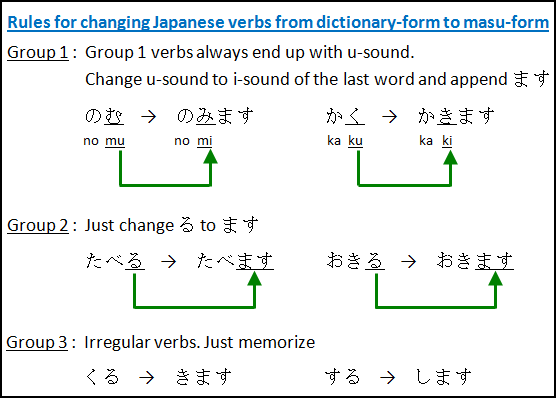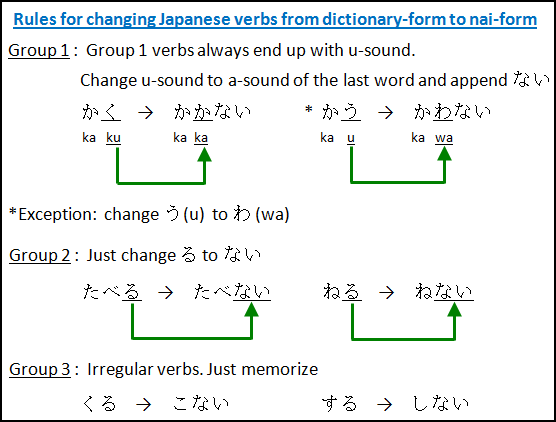- Home
- Basic Lessons
- Japanese Verbs Part 2
Japanese Verbs Part 2
Dictionary-form and Nai-form -
Free Japanese Lessons: 19
In this lesson, you will get to learn how to change Japanese verbs from dictionary-form to ます-form (masu-form) and ない-form (nai-form).
There are some rules that you need to follow in order to change verbs from dictionary-form to other forms.
Rules for Changing dictionary-form to masu-form
The following are the rules for the 3 groups of Japanese verbs.
Group 1 Verbs
Group 1 verbs always end up with words containing u-sound. To change group 1 verbs to masu-form, change the u-sound to i-sound in the last word.
After that append ます (masu) to the changed words and you will get the masu-form of the verb.
For example, this group 1 verb のむ (nomu) ends up with む (mu). If you change the u-sound to i-sound, む (mu) becomes み (mi).
Adding ます (masu) at the end, you will get のみます (nomimasu).
Let's look at one more example, this group 1 verb かわる (kawaru) ends up with る (ru).
If you change the u-sound to i-sound, る (ru) becomes り (ri). Adding ます (masu) at the end, you will get かわります (kawarimasu).
Group 2 Verbs
Changing group 2 verbs from dictionary-form to masu-form is much simpler.
All group 2 verbs end up with る (ru). To change to masu-form, simply replace る (ru) with ます (masu) and you will get the masu-form of the verb.
For example, this Japanese verb たべる (taberu) is a group 2 verb. To change to masu-form, replace る (ru) with ます (masu) and you will get たべます (tabemasu).
I will use another example to show the change. This group 2 verb ねる (neru) means go to bed. Change る (ru) to ます (masu) and you will get ねます (nemasu).
Group 3 Verbs
Group 3 verbs are irregular verbs. You just need to memorize them. The masu-form of くる (kuru) is きます (kimasu) and the masu-form of する (suru) is します (shimasu).
In summary, the following diagram shows the rules when changing dictionary-form to masu-form for Japanese verbs.

Rules for Changing dictionary-form to nai-form
For this section you will learn how to change dictionary-form (Plain Present Affirmation) to nai-form (Plain Present Negative).
The following are the rules for the 3 groups of Japanese verbs.
Group 1 Verbs
To change group 1 verbs from dictionary-form to nai-form, change the u-sound to a-sound in the last word. After that append ない (nai) to the changed words and you will get the nai-form of the verb.
For example, this group 1 Japanese verb かく (kaku) ends up with く (ku). If you change the u-sound to a-sound, く (ku) becomes か (ka). Adding ない (nai) at the end, you will get かかない (kakanai).
However there is one exception. For group 1 verbs end up with the word う (u), instead of changing it to あ (a), you need to change it to わ (wa).
For example, this group 1 verb かう (kau) ends up with う (u). Therefore you need to change う (u) to わ (wa). Adding ない (nai) at the end, you will get かわない (kawanai).
Group 2 Verbs
Group 2 verbs are much simpler. You just need to change る (ru) to ない (nai) and you will get the nai-form Japanese verbs.
Group 3 Verbs
Group 3 verbs are irregular verbs. You just need to memorize them. The nai-form of くる (kuru) is こない (konai) and the nai-form of する (suru) is しない (shinai).
In summary, the following diagram shows the rules when changing dictionary-form to nai-form for Japanese verbs.

Examples of Changing Japanese Verbs to masu-form and nai-form
Let's see some examples of changing Japanese verbs from dictionary-form to masu-form and nai-form.
Group 1 Verbs
| dict-form | Meaning | masu-form | nai-form | |
| 1. | ある | Exist (Thing) | あります | |
| 2. | かかる | Hang/Take | かかります | かからない |
| 3. | よむ | Read | よみます | よまない |
| 4. | のむ | Drink | のみます | のまない |
| 5. | きく | Listen/Ask | ききます | きかない |
| 6. | みがく | Brush | みがきます | みがかない |
| 7. | あらう | Wash | あらいます | あらわない |
| 8. | かう | Buy | かいます | かわない |
| 9. | いく | Go | いきます | いかない |
| 10. | かえる | Go Back | かえります | かえらない (Exception, not Grp 2) |
| 11. | はいる | Enter | はいります | はいらない (Exception, not Grp 2) |
| 12. | はしる | Run | はしります | はしらない (Exception, not Grp 2) |
| 13. | のる | Get On/Ride | のります | のらない |
| 14. | わかる | Understand | わかります | わからない |
| 15. | おくる | Send | おくります | おくらない |
| 16. | およぐ | Swim | およぎます | およがない |
| 17. | あそぶ | Play | あそびます | あそばない |
| 18. | かく | Write | かきます | かかない |
| 19. | だす | Take Out/Submit | だします | ださない |
| 20. | とる | Take/Pick Up | とります | とらない |
| 21. | ひく | Pull/Play (Piano) | ひきます | ひかない |
| 22. | おろす | Lower/Get Down | おろします | おろさない |
| 23. | はなす | Speak/Talk | はなします | はなさない |
| 24. | まつ | Wait | まちます | またない |
| 25. | はじまる | Begin/Start | はじまります | はじまらない |
| 26. | おわる | End/Finish | おわります | おわらない |
| 27. | おもう | Think/Feel | おもいます | おもわない |
| 28. | もらう | Receive/Get | もらいます | もらわない |
Group 2 Verbs
| dict-form | Meaning | masu-form | nai-form | |
| 1. | いる | Exist (Human/Animal) | います | いない |
| 2. | たべる | Eat | たべます | たべない |
| 3. | みる | See | みます | みない |
| 4. | あびる | Bathe/Shower | あびます | あびない |
| 5. | でる | Appear/Leave | でます | でない |
| 6. | おりる | Alight/Get Off | おります | おりない |
| 7. | みえる | Be Seen/Seem/Appear | みえます | みえない |
| 8. | きこえる | Be Heard/Said to be | きこえます | きこえない |
| 9. | むかえる | Welcome/Greet | むかえます | むかえない |
| 10. | ねる | Go to Bed | ねます | ねない |
| 11. | おきる | Wake Up/Rise/Happen | おきます | おきない |
| 12. | あげる | Give/Offer/Raise | あげます | あげない |
| 13. | くれる | Be Given/Let One Have | くれます | くれない |
Group 3 Verbs
| dict-form | Meaning | masu-form | nai-form | |
| 1. | くる | Come/Arrive | きます | こない |
| 2. | する | Do/Execute/Play | します | しない |
| 3. | べんきょうする | Study | べんきょうします | べんきょうしない |
| 4. | さんぽする | Walk/Stroll | さんぽします | さんぽしない |
Related Pages
Lesson 18: Verbs.
Lesson 20: Verbs on give and receive.
Lesson 21: Verbs te-form.
Lesson 22: Verbs on Progress Action, Habitual Action & Occupation.
Lesson 23: Verbs of Motion & How to Make Request in Japanese.
Lesson 29: Verbs on State Continuation.
Lesson 30: Verbs - Transitive and Intransitive verbs.
Lesson 31: Verbs on State Continuation Transitive/Intransitive.
Ready Set Speak Sale! Get 40% OFF Forever on Premium & Premium PLUS plans! Ends on 18 Apr 2025
The link above is an affiliate link, which means that I would earn a commission (at no extra cost to you) if you do end up purchasing the related learning course.
Previous - Lesson 18: Verbs
Buy me a coffee








Facebook Comments
Don’t see the comments box? Log in to your Facebook account, give Facebook consent, then return to this page and refresh it.